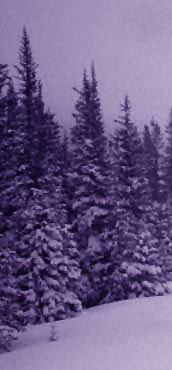

 |
by Rachel Hauser January 3, 2002 |
||
|
Snow falls to the ground following the path of least resistance. In the boreal forests of North America, depth and melt patterns of snow on the forest floor depend largely on the location and density of the standing vegetation. Precipitation, particularly in the form of snow, strongly influences regional land-atmosphere interactions, ultimately impacting global climate. Climate modelers trying to replicate climate change on a global scale need to better understand smaller scale regional climate dynamics to account for the nuances of climate variability.
|
 (Image courtesy of Richard Armstrong, National Snow and Ice Data Center) For more information, visit the Oak Ridge National Laboratory DAAC and the BOREAS Project. (A new browser window will open.) |
Snow lingers in the forests for up to six months of the year but acquiring adequate snow data is impractical in this largely uninhabited region of Canada. In an effort to fill the data gap, researchers with the Boreal Ecosystem Atmosphere Study (BOREAS) collected ground and airborne snow cover measurements. Using these data, Anne Walker, an environmental scientist at Environment Canada's Climate Research Centre, and her colleagues revised their method of snow cover detection on the Canadian Prairies to operate in the forest with positive results.
The Climate Research Centre successfully designed a means of identifying snow pack properties using space-borne satellite imagery on the Prairies, another sparsely populated area. However, differences in vegetation and snow cover duration underestimated the amount of snow in the boreal forests using this method, said Walker. Snow depth varies substantially in the forest, depending upon the number of openings among the trees and the mixture and size of tree species, said Walker. Attaining an accurate estimate of mean snow depth and snow water equivalent in the boreal forest is challenging using satellite imagery because the vegetation impacts the clarity of the remotely sensed snow data, she said. The BOREAS winter field campaign involved taking detailed ground-based measurements along a set of flight lines surveyed by airborne remote sensing instruments, said Walker. "By comparing the remotely sensed data with snow measurements taken by a crew on the ground and the type of vegetation present in each image we got a sense of how snow cover was influenced by vegetation and how this in turn was represented in the satellite imagery," Walker said. Detailed ground-based snow measurements and maps indicating the dominant vegetation in an area were used in combination to predict how snow cover might look in satellite images under variable conditions. "To validate this method of determining snow cover, the following winter we went back and repeated what we had done for BOREAS," said Walker. Ground surveys and snow data from the U.S. National Weather Service were acquired along a 10 to 20 km flight line. Researchers at the Climate Research Centre then compared these data to microwave measurements for the same region. At the end of this process, Walker and her colleagues discovered that their calculations of water equivalent were very good for 1995. However, very low air temperatures in 1994 resulted in an overestimation of water equivalent. Climate Research Centre scientists continue to compare ground-based and satellite data for different areas of the BOREAS study sites. Additionally, arrangements have been made for more airborne microwave flights over different forests to collect a time series of snow data to see how representative the BOREAS snow data are in larger, more northerly regions. "We are improving land cover statistics that we will compare to the surface measurements to more precisely determine the relationship between vegetative cover and snow detection, " Walker said. Goita, K., A. E. Walker, B. E. Goodison, and A. T. C. Chang. 1997. Estimation of Snow Water Equivalent in the Boreal Forest Using Passive Microwave Data. Proceedings, GER '97 (International Symposium: Geomatics in the Ear of Radarsat), Ottawa, Canada, May 25-30, 1997. CD-ROM published by Natural Resources Canada and National Defence. |
|